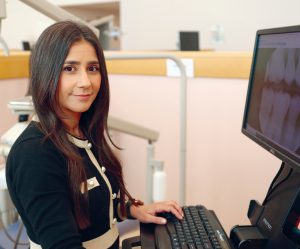
When Dr. Juliana (Julie) Pfeffer was growing up, she thought all dentists conducted research, taught dental students and delivered care, because her parents did all three.
“Conversations around the dinner table were always about patient cases,” she remembers.
Pfeffer followed her mother and father – former faculty members at UM and the University of Toronto (U of T), respectively – into both dentistry and academia. She’s now an assistant professor of restorative dentistry at the Dr. Gerald Niznick College of Dentistry.
Pfeffer’s research encompasses two areas: dental education and her work as an attending dentist at the Health Sciences Centre (HSC) adult dental clinic, which treats people with developmental disabilities, people who are severely medically compromised, and hospital patients who require dental care.
In a recent dental education research project, Pfeffer tested what types of instructional videos first-year students find useful. She wanted to know if students preferred a video with a charismatic instructor using humour and anecdotes, or a straight-forward time-lapse video focused on the technical aspects of a procedure.
The results revealed that students found both styles of video helpful. In fact, they wanted access to both types for every procedure they’re required to learn.
“First-year dental school is really hard,” Pfeffer says. “If we can make it easier, that’s not only good for the learners, that’s going to be better for their patients.”
Pfeffer, who grew up in Winnipeg and Toronto, earned her bachelor of science from U of T and her doctor of dental surgery from the University of Western Ontario. She completed a general practice residency at HSC before joining UM’s dental school as a part-time faculty member in 2013, becoming full time in 2017.
A current study by Pfeffer is underway at the HSC adult dental clinic. It can be difficult, she says, to place an intravenous (IV) line in the hand of a patient with developmental disabilities in order to sedate them for a procedure.
The HSC clinical team has long given the patient an oral sedative first, to calm them before the IV placement. Within the last year, they changed the makeup of the oral sedative.
There is a lack of published data on this specific approach to dental sedation in adults with developmental disabilities, Pfeffer says. So she is conducting a retrospective chart review.
“Anecdotally, we think it’s been very effective. But unless you do the research, you don’t know 100 per cent. Research is so important for ensuring that practice guidelines reflect up-to-date scientific evidence.”
Pfeffer was one of 32 experts who sat on a national panel, the Canadian Dental Oncology Network Consensus Group, that developed clinical practice guidelines for managing patients’ dental care prior to radiation therapy for head and neck cancer.
Part of the panel’s consensus was determining which teeth that have certain conditions, such as periodontal disease, should be extracted before radiation therapy. “This reduces the risk of a serious side effect, osteoradionecrosis, that can happen if extractions are done after radiation,” Pfeffer says.
The guidelines were published in the journal Oral Oncology in 2021. “If I can be part of providing guidelines like this, that’s really interesting and rewarding to me,” Pfeffer says.
BY MATTHEW KRUCHAK
